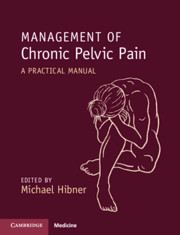Book contents
- Management of Chronic Pelvic Pain
- Management of Chronic Pelvic Pain
- Copyright page
- Contents
- Contributors
- Foreword
- Chapter 1 Introduction to Chronic Pelvic Pain
- Chapter 2 Neurobiological Basis of Pelvic Pain
- Chapter 3 History and Evaluation of Patients with Chronic Pelvic Pain
- Chapter 4 Psychological Assessment of a Female Patient with Chronic Pelvic Pain
- Chapter 5 Musculoskeletal Assessment for Patients with Pelvic Pain
- Chapter 6 Pharmacological Management of Patients with Pelvic Pain
- Chapter 7 Evidence for Surgery for Pelvic Pain
- Chapter 8 Pelvic Pain Arising from Endometriosis
- Chapter 9 Bladder Pain Syndrome
- Chapter 10 Pelvic Pain Arising from Pelvic Congestion Syndrome
- Chapter 11 Irritable Bowel Syndrome
- Chapter 12 Vulvodynia
- Chapter 13 Pelvic Pain Arising from Adhesive Disease
- Chapter 14 Pelvic Pain Arising from Ovarian Remnant Syndrome
- Chapter 15 Pudendal Neuralgia
- Chapter 16 Other Peripheral Pelvic Neuralgias
- Chapter 17 Chronic Pain After Gynecological Surgery
- Chapter 18 Pain Arising from Pelvic Mesh Implants
- Chapter 19 Treatment of Sexual Dysfunction Arising from Chronic Pelvic Pain
- Chapter 20 Physical Therapy Interventions for Musculoskeletal Impairments in Pelvic Pain
- Chapter 21 If Everything Else Fails
- Index
- References
Chapter 5 - Musculoskeletal Assessment for Patients with Pelvic Pain
Published online by Cambridge University Press: 08 March 2021
- Management of Chronic Pelvic Pain
- Management of Chronic Pelvic Pain
- Copyright page
- Contents
- Contributors
- Foreword
- Chapter 1 Introduction to Chronic Pelvic Pain
- Chapter 2 Neurobiological Basis of Pelvic Pain
- Chapter 3 History and Evaluation of Patients with Chronic Pelvic Pain
- Chapter 4 Psychological Assessment of a Female Patient with Chronic Pelvic Pain
- Chapter 5 Musculoskeletal Assessment for Patients with Pelvic Pain
- Chapter 6 Pharmacological Management of Patients with Pelvic Pain
- Chapter 7 Evidence for Surgery for Pelvic Pain
- Chapter 8 Pelvic Pain Arising from Endometriosis
- Chapter 9 Bladder Pain Syndrome
- Chapter 10 Pelvic Pain Arising from Pelvic Congestion Syndrome
- Chapter 11 Irritable Bowel Syndrome
- Chapter 12 Vulvodynia
- Chapter 13 Pelvic Pain Arising from Adhesive Disease
- Chapter 14 Pelvic Pain Arising from Ovarian Remnant Syndrome
- Chapter 15 Pudendal Neuralgia
- Chapter 16 Other Peripheral Pelvic Neuralgias
- Chapter 17 Chronic Pain After Gynecological Surgery
- Chapter 18 Pain Arising from Pelvic Mesh Implants
- Chapter 19 Treatment of Sexual Dysfunction Arising from Chronic Pelvic Pain
- Chapter 20 Physical Therapy Interventions for Musculoskeletal Impairments in Pelvic Pain
- Chapter 21 If Everything Else Fails
- Index
- References
Summary
Pelvic floor assessment is probably the most important part of the physical examination in patients with chronic pelvic pain and this exam is best performed by a skilled pelvic floor physical therapist. Physicians who see a large number of patients with pelvic pain should probably partner with a physical therapist and refer those patients for assessment. Some of the red flags on the history part of the assessment for pelvic floor dysfunction are urinary hesitancy (delayed onset of urine flow when trying to urinate) and pain after intercourse, or pain with physical activity (post exertion muscle soreness). Patients with pelvic floor muscle spasms also often have discomfort and pain with use of tampons, vaginal probe ultrasound, and pelvic exam. On pelvic exam when palpating with one finger muscles may feel tight and tender, often to the point where the examiner is not able to insert one finger. The obturator internus muscle is best palpated during the pelvic exam in the lithotomy position with the patient pushing with her knee against the examiner’s external hand.
- Type
- Chapter
- Information
- Management of Chronic Pelvic PainA Practical Manual, pp. 33 - 49Publisher: Cambridge University PressPrint publication year: 2021

